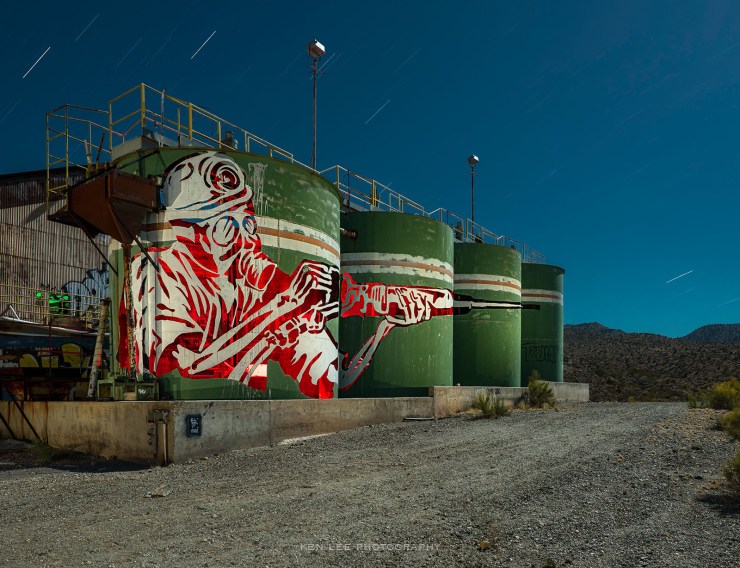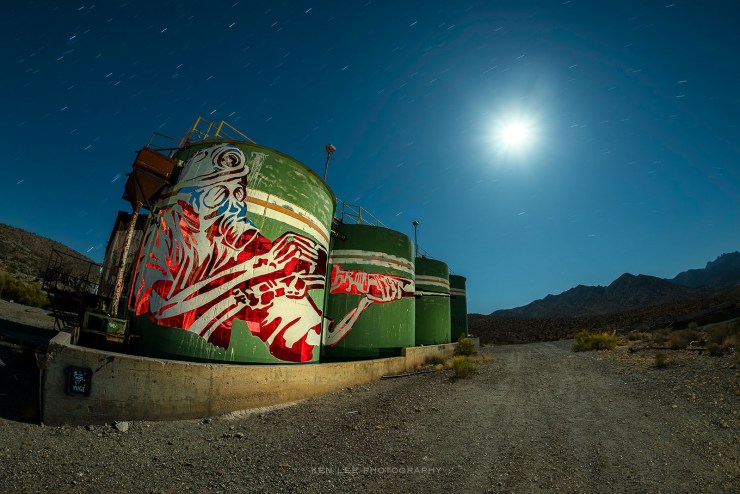This is an old mining site located deep within the Mojave Desert. Guerrilla artists came and carved this art, depicting a miner with equipment on cyanide tanks. This was an artistic statement commenting on the destruction of the ecology on this site. But it makes for interesting night photography subjects.
I lined up my camera so that the art would appear “intact” on all four of the cyanide tanks. Then I set about illuminating them.

Step 1: Setting the light for a brilliant red
I set my handheld ProtoMachines LED2 light painting device for a brilliant red. Red would be urgent and emotional. I wanted a good amount of saturation, but one must be careful of blowing highlights with red. Why? Digital cameras are typically very sensitive to red light.
100% saturation doesn’t always work well, depending on how bright the light is and how long the subject is illuminated. I find that a setting around 65-70% is often sufficient. If you do not have a ProtoMachines, I would recommend using a red gel in front of an LED flashlight for quality results.
Step 2: Illuminating the interior of the tanks to glow from within
I had to stick my ProtoMachines inside each of the canisters. For the one closest to the camera, I lit it from three different angles, moving quickly so I would not “register” as a faint black smudge in the image if I stood still for too long. I bounced the light around inside, making sure to “paint” everything evenly. Then for the second canister, I was able to hide behind the first canister.
I had to be careful for two reasons. One is that some of the openings were jagged from the artists carving into the metal. The second was that I had to make sure I had a firm grip on the ProtoMachines. If I dropped it, I would probably not be able to retrieve it.
Step 3: Illuminating the exterior of the tanks
I switched my ProtoMachines to a warm white light. I stood to camera right and illuminated the tanks. I did this in part because I wanted the white paint to be whiter than what they would appear to be. I kept the light moving, sweeping, painting gently so that it would be even. It really is painting with light.
Step 4: Illuminating the front tank from another angle
I illuminated the front tank from camera left for a short while. I normally would not do this, but I wanted the white paint to glow more evenly. Ordinarily, I would leave this in shadow for a more “natural” look.
Step 5: Creating texture on the ground
There was one finishing touch to complete this image. I wanted to create a little bit of texture on the ground. I stood to camera right, but far away. I held the light very low to the ground and gently “swept” the ground with light to pick up some extra shadow and texture. It’s very subtle, and if I didn’t mention it, you probably wouldn’t know it.
Another view
For good measure, I created a fisheye version. Enjoy!

Tell your story with the second annual Visual Storytelling Conference!
Experience four days of interactive, online training sessions featuring a range of educational content with experienced photographers and content creators. This free event kicks off with a series of technical boot camps to build essential skills, followed by live, online sessions on photography, video, business and social media. Join live from March 10-13, 2022!
